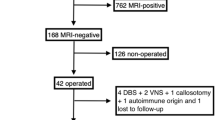Abstract
MEG is still rarely used for presurgical epilepsy evaluations. We report the case of a 51-year-old male patient suffering from frontal lobe epilepsy. MEG revealed the first convincing localizing hint in this case whose epilepsy had previously been considered to be cryptogenic.
From its onset at age 9 years, the patient's epilepsy remained drug-resistant with up to 40 seizures per day despite having tried the use of more than 15 anticonvulsants. Simple partial seizures with epigastric auras, tonic and mild hypermotor symptoms were attributed to the frontal lobe mainly due to the high seizure frequency and the short seizure duration. However, no constant clinical lateralization signs were present. All interictal EEG recordings were normal over the years. Several long-term video EEGs were recorded. Ictal EEG patterns preceded the clinical onset but showed mostly generalized flattening. Ictal bifrontal 20–25 Hz beta activity had a left hemisphere preponderance only in a few instances. High-resolution MRI showed diffuse cerebral atrophy including both hippocampi and diffuse white matter changes in both hemispheres. Focal cortical dysplasia (FCD) within the left frontal lobe was suspected but not confirmed.
Only diffuse white matter changes dominated a first morphometric analysis of a high-resolution MPRAGE 3D-MRI. Interictal FDG-PET detected a hypometabolism in the right mesiotemporal lobe. Simultaneous 122-channel MEG and 32-channel EEG were recorded in November 2004 in Heidelberg. No interictal spikes were detected. A typical seizure was recorded and no lateralized EEG pattern was found. In contrast, a focal beta pattern within the right frontal lobe and bilateral propagation was identified by MEG. Source analysis revealed a localization near the right-sided medial frontal sulcus. Because of MEG findings, diagnostic work-up was reinitiated. A suspect region revealed by the prior morphometric MRI analysis corresponded to the functional abnormality and was newly interpreted as FCD. Interictal SPECT was discordant because of left temporal hypoperfusion, but ictal hyperperfusion agreed well with the MEG result. Finally, the meanwhile installed 3-Tesla MRI revealed a focal lesion indicative for FCD in the area of the known pathologic findings. Lesionectomy was guided by ECoG in July 2005 and histopathology revealed a FCD with balloon cells. The patient remained seizure free postoperatively with a follow-up of 16 months.
Zusammenfassung
Das MEG stellt nach wie vor eine vernachlässigte Außenseitermethode in der nichtinvasiven prächirurgischen Epilepsiediagnostik dar. Wir berichten den Fall eines 51-jährigen Patienten mit bis dato kryptogener Frontallappenepilepsie, bei dem ein iktales MEG den ersten richtungsweisenden lokalisatorischen Befund erbrachte.
Im Alter von 9 Jahren begann eine pharmakorefraktäre Epilepsie. Trotz des Einsatzes von mehr als 15 Antikonvulsiva traten bis zu 40 Anfälle täglich auf. Die einfachfokalen Anfälle mit abdomineller Aura konnten aufgrund ihrer tonischen und milden hypermotorischen Symptomatik dem Frontallappen zugeordnet werden. Allerdings bestanden keine konstanten klinischen Lateralisationszeichen. Interiktale EEGs waren immer normal. In mehreren Langzeit-Video-EEG-Ableitungen zeigten sich der Klinik vorausgehende iktale EEG-Veränderungen mit generalisierter Abflachung und bifrontaler, manchmal links betonter 20–25 Hz Betaaktivität. Hochauflösende MRTs stellten eine diffuse Atrophie einschließlich beider Hippocampi sowie diffuse Marklagerläsionen bds. frontoparietotemporal dar. Es wurde ein vager Verdacht auf eine fokale kortikale Dysplasie (FCD) links frontal geäußert. In einer ersten morphometrischen MRT-Analyse auf Basis eines T1-Volumendatensatzes waren lediglich die Marklagerveränderungen auffällig. Das interiktale FDG-PET zeigte einen Hypometabolismus rechts mesiotemporal. In Heidelberg erfolgte 11/2004 die Ableitung eines simultanen 122-Kanal-MEG und 32-Kanal-EEG. Interiktale Spikes wurden nicht dargestellt. Ein habitueller Anfall ohne lateralisiertes EEG-Anfallsmuster imponierte im MEG jedoch mit einem umschriebenen Betamuster rechts frontal und einer bilateralen Propagation. Die Quellenanalyse legte eine Genese im Bereich des Sulcus frontalis medius rechts nahe. Aufgrund des MEG-Befundes wurde die Diagnostik nochmals aufgenommen. Ein vormals in der morphometrischen MRT-Analyse auffälliger Bereich rechts frontal korrespondierte nun zu dem funktionellen Befund und wurde neu im Sinne eines Verdachts auf FCD bewertet. Ein interiktales SPECT war linksseitig und temporal auffällig. Die Hyperperfusion im iktalen SPECT war jedoch konkordant zum rechtsseitigen MEG-Befund. Schließlich zeigte das gerade neu verfügbare 3-Tesla-MRT in höchster Auflösung neben den bekannten Veränderungen eine umschriebene Läsion, verdächtig auf eine FCD. In 07/2005 erfolgte unter ECoG die Läsionektomie einer FCD mit Ballonzellen. Der Patient ist seit 16 Monaten postoperativ anfallsfrei.
Similar content being viewed by others
Literatur
Bast T, Oezkan O, Rona S et al (2004) EEG and MEG source analysis of single and averaged interictal spikes reveals intrinsic epileptogenicity in focal cortical dysplasia. Epilepsia 45:621–631
Bast T, Ramantani G, Seitz A, Rating D (2006) Focal cortical dysplasia: prevalence, clinical presentation and epilepsy in children and adults. Acta Neurol Scand 113:72–81
Jonghe A de, Munck JC de, Goncalves SI, Ossenblok P (2005) Differences in MEG/EEG epileptic spike yields explained by regional differences in signal-to-noise ratios. J Clin Neurophysiol 22:153–158
Fauser S, Schulze-Bonhage A, Honegger J et al (2004) Focal cortical dysplasias: surgical outcome in 67 patients in relation to histological subtypes and dual pathology. Brain 127:2406–2418
Huppertz HJ, Grimm C, Fauser S et al (2005) Enhanced visualization of blurred grey-white matter junctions in focal cortical dysplasia by voxel-based 3D MRI analysis. Epilepsy Res 67:35–50
Author information
Authors and Affiliations
Corresponding author
Rights and permissions
About this article
Cite this article
Bast, T., Huppertz, HJ., Bilic, S. et al. Iktale Magnetoenzephalographie (MEG) und modernste multimodale Diagnostik führen zur Operationsindikation nach 40 Jahren pharmakorefraktärem Verlauf einer scheinbar kryptogenen Frontallappenepilepsie. Z. Epileptol. 20, 41–48 (2007). https://doi.org/10.1007/s10309-007-0226-4
Received:
Accepted:
Issue Date:
DOI: https://doi.org/10.1007/s10309-007-0226-4




